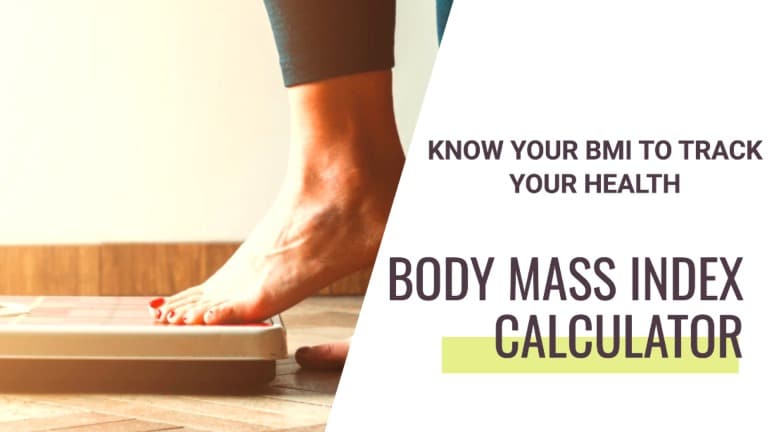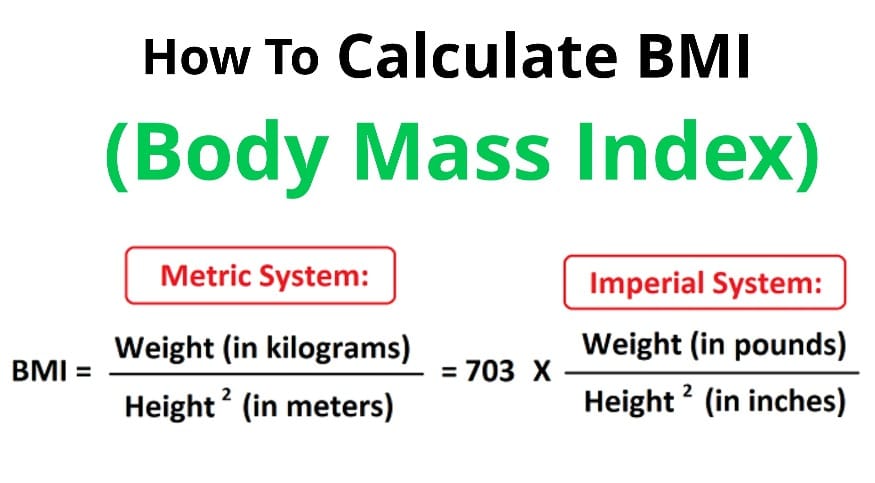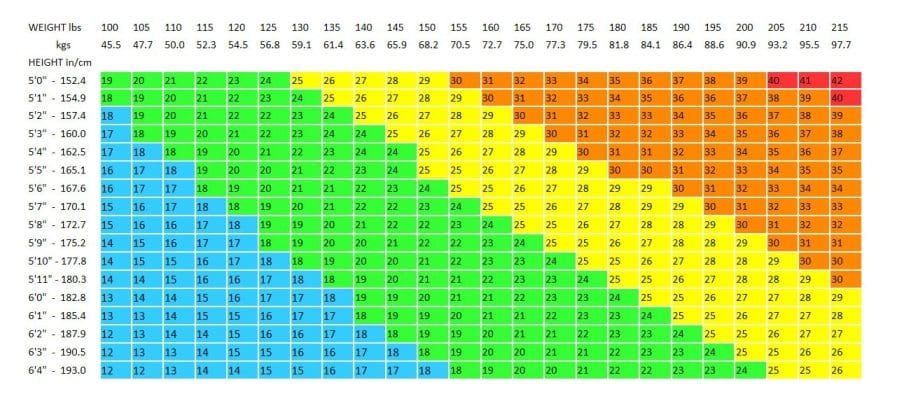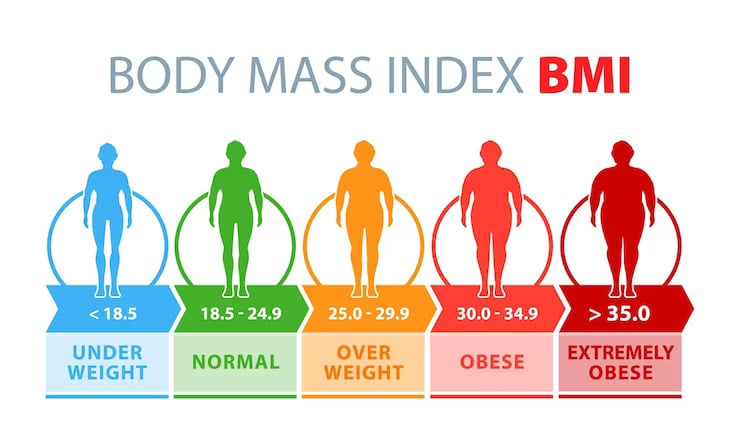
BMI Calculator
Your BMI: []
BMI Classification:
Underweight = <18.5
Normal weight = 18.5–24.9
Overweight = 25–29.9
Obese = BMI of 30 or greater
What is BMI
BMI stands for Body Mass Index, and it measures body fat based on a person’s weight and height.
The BMI is calculated by dividing a person’s weight in kilograms by the square of their height in meters. The result then determines whether the person is underweight, normal, overweight, or obese.
The body mass index is a screening tool used to identify potential health risks associated with a person’s weight. However, it is important to note that the index is not a perfect measure of health, as it does not consider factors such as body fat, muscle mass, body composition, or overall health.
It should be combined with other health assessments to understand better how healthy and fit someone is.
Know More: 100+ Safe And Fast Ways To Lose Weight (Backed By Science)

How To Calculate BMI
To calculate your BMI manually, you must determine your weight and height.
Here are the steps to calculate BMI:
1. Measure your weight
You can use a scale to measure your weight in kilograms.
If you don’t have access to a scale that measures kilograms, you can convert your weight from pounds to kilograms by dividing your weight in pounds by 2.205.
2. Measure your height
Use a tape measure or ruler to measure your height in meters.
If you don’t have access to a metric tape measure or ruler, you can convert your height from feet and inches to meters by multiplying your height in feet by 0.3048 and adding your height in inches multiplied by 0.0254.
The BMI formula divides a person’s weight in kilograms by the square of their height in meters.
The Formula for Calculating BMI is
BMI Metric Units formula (kg, cm, m):
- BMI = (weight (kg) / height^2 (m^2))
For example, if you weigh 70 kilograms and are 1.75 meters tall, your BMI would be calculated as follows:
- BMI = 70 kg / (1.75 m × 1.75 m) BMI = 22.86
- Your BMI is 22.86, which is a healthy weight.
BMI Imperial Units formula (Inch and Pound):
Calculate BMI by dividing weight in pounds (lbs) by height in inches (in) squared and multiplying by a conversion factor of 703.
- BMI = 703 x Weight (lbs) / Square of height in inches
For example, if you weigh 150 lbs and are 65 inches tall, your BMI would be calculated as follows:
- BMI: [150 ÷ (65)2] x 703 = 24.96
- Your BMI is 24.96, which is a healthy weight.

BMI Classifications
The BMI classifications for overweight and obese (Nuttall, 2015).
| BMI | Disease Risk | Classification |
|---|---|---|
| < 18.5 | Increased | Underweight |
| 18.5–24.9 | Low | Healthy weight |
| 25.0–29.9 | Increased | Overweight |
| 30.0–34.9 | High | Obese |
| 35.0–39.9 | Very high | Obesity II |
| ≥ 40.0 | Extremely high | Obesity III |
BMI Categories
The formula for calculating BMI is the same for both men and women; it is based solely on weight and height.
BMI Chart For Men and Women
The mass index (BMI) is a useful tool for assessing whether your weight is appropriate for your height. Deviating from the recommended weight range based on height can pose health risks in the long run.
Although BMI should not be the sole factor to consider for one’s health and fitness, it is a helpful starting point.
To calculate BMI, you must know their height and weight and compare it with the BMI chart.

BMI Table for Both Males and Females
The resulting number is then compared to BMI categories that have been established by the World Health Organization (WHO) and other health organizations. These categories include:
- Underweight: less than 18.5
- Normal weight: 18.5 to 24.9
- Overweight: 25 to 29.9
- Obese: 30 to 35
- Morbid obesity: Over 35
Obesity is frequently subdivided into categories:
- Obesity Class 1: BMI of 30 to < 35
- Obesity Class 2: BMI of 35 to < 40
- Obesity Class 3: BMI of 40 or higher. Class 3 obesity is sometimes categorized as “severe” obesity.

BMI Chart for Children and Teens, age 2-20
The Centers for Disease Control and Prevention (CDC) BMI-for-age percentiles growth charts.
However, the BMI scale used to interpret the results may differ slightly for males and females. Males tend to have more muscle mass than females, which can affect their body mass index.
BMI Table for Children and Teens, Age 2-20
Using a standard adult BMI chart is inappropriate as a child’s body undergoes rapid development and changes. Instead, doctors use a specific chart to monitor whether a child’s weight is appropriate for their height.
To determine this, doctors calculate the child’s BMI using their height and weight. The resulting BMI value is then compared to other children of the same age and gender using percentages and percentiles. Weight categories for children are established based on these percentiles, including:
For example, a 25th percentile BMI for a 6-year-old female child would indicate that the child's weight is higher than 25% of girls aged 6.
The Centers for Disease Control and Prevention (CDC) recommends categorizing children and teens between the ages of 2 and 20 by BMI.
| Category | Percentile Range |
| Underweight | <5% |
| Healthy weight | 5% – 85% |
| At risk of overweight | 85% – 95% |
| Overweight | >95% |
How to Calculate BMI for Athletes
Calculating BMI for athletes is the same as for non-athletes. However, because athletes or bodybuilders tend to have higher levels of muscle mass, which weighs more than fat, BMI may not accurately measure their body fat.
Other methods, such as skinfold measurements or bioelectrical impedance analysis, may be more appropriate in such cases.
Athletes should talk to a healthcare professional or sports nutritionist who can review their bodies and make recommendations.
BMI Calculator For Seniors
A body mass index can be used as a screening tool for seniors, but it may not be the most accurate measure of body fat for older adults.
It’s because older adults may have changes in their body composition, like a decrease in muscle mass and an increase in body fat, which can affect BMI values.
The same formula is used to calculate BMI for seniors as for other adults: weight in kilograms divided by height in square meters. However, the results may be interpreted differently.
According to the World Health Organization, a BMI value of 18.5-24.9 is considered a healthy weight range for adults aged 18–65, but a slightly higher BMI may be more appropriate for seniors.
Seniors should talk to a healthcare provider or registered dietitian, who can advise them based on their needs and health status.
Importance and Benefit of Measuring BMI
Body Mass Index (BMI) is an important measure of body fat that provides a quick and easy way to screen for potential health risks related to weight.
Here are some reasons why BMI is important:
1. Assessing Health Risks
A BMI is a useful tool for identifying who is at increased risk for health problems related to their weight, such as type 2 diabetes, heart disease, high blood pressure, and certain types of cancer.
Research has shown that people with higher BMI have an increased risk of these health problems.
2. Simple Screening Tool
A quick and easy screening tool that healthcare professionals can use to identify who may need further evaluation or treatment for weight-related health issues.
3. Motivation for Lifestyle Changes
BMI can be a motivator for people who are overweight or obese to make lifestyle changes to improve their health.
Having a healthy body mass index can help you achieve a healthier weight and reduce your risk of weight-related health problems.
4. Widely Recognized
BMI is a measure of body fat that doctors and researchers worldwide use.
This universal recognition makes comparing results across different groups and studies easy.
5. Free of Cost
Compared to more expensive and invasive measures of body composition, such as dual-energy X-ray absorptiometry (DEXA) scans, BMI is a cost-effective option for assessing body fat.
Limitations of BMI
Understanding the benefits and limitations of body mass index (BMI) can help you take steps to improve your health and reduce your risk of weight-related health problems.
There are several limitations to consider, including:
- BMI does not consider differences in body composition, such as muscle mass.
- It does not tell the difference between different types of body fat, such as subcutaneous fat and visceral fat.
- The body mass index may not accurately measure body fat in older adults, men and women of different ages, or individuals of different ethnicities.
- The body mass index doesn’t consider an individual’s overall health status or other risk factors for weight-related health problems, such as diabetes or heart disease.
Health Risks Related To Being Overweight (High BMI)
Being overweight can increase the risk of developing several health problems, including:
- Fat accumulation makes it difficult for the body to utilize insulin properly. It is associated with high blood sugar levels and an increased risk of developing type 2 diabetes.
- Being overweight can increase the workload on the heart and blood vessels. It increases high blood pressure and increases the risk of heart disease and stroke.
- Excess body fat can increase levels of cholesterol and triglycerides in the blood. The buildup of plaque in the arteries increases the risk of heart disease.
- Excessed body fat can increase the risk of developing blood clots, which can lead to a stroke.
- Body fat accumulation can make breathing difficult during sleep, leading to sleep apnea and other sleep-related concerns.
- Extra weight stresses the joints, leading to joint pain and an increased risk of getting arthritis.
- Fat accumulation in the liver can lead to fatty liver disease and an increased risk of liver damage.
- Increase your risk of getting gallstones or other gallbladder problems.
- The risk of developing kidney disease and other kidney issues is increased.
- Infertility and polycystic ovary syndrome can be caused by excess body fat, which can affect hormone levels and lead to reproductive problems.
- Obesity can cause feelings of low self-esteem, depression, and anxiety.
- Excess body fat can make breathing harder and increase the risk of respiratory problems, including asthma and shortness of breath.
- Increase the risk of developing acid reflux, heartburn, and other digestive issues.

The Risks of Being Underweight (Low BMI)
Being underweight can also increase the risk of several health problems, including:
- Being underweight can indicate malnutrition, leading to deficiencies in essential nutrients such as protein, vitamins, and minerals.
- Malnutrition can weaken the immune system, making it difficult for the body to fight off infections and illnesses.
- Malnutrition can lead to a lack of iron and other essential nutrients needed to produce red blood cells, resulting in anemia and its associated symptoms.
- A low BMI can increase the risk of getting osteoporosis and other bone-related problems because a low body weight can lead to a loss of bone density.
- Being underweight can affect hormone levels and lead to reproductive problems, including irregular periods and infertility.
- Being underweight can have a negative impact on growth and development, especially in children and adolescents.
Maintaining a healthy weight through a balanced diet and regular exercise can reduce these health risks.
Best Tip For Improving BMI and Health
People can take several actions towards better health, including:
1. Eating a Balanced Diet
Eating a diet rich in fruits, vegetables, whole grains, lean proteins, and healthy fats can give the body the essential nutrients it needs to function properly.
2. Do Regular Exercise
Exercising regularly is essential for fat loss and overall health. It burns calories, boosts metabolism, and builds muscle mass.
Regular exercise can also help improve mood, reduce stress, and improve overall cardiovascular health. (1).
Related Post: 10 Best Exercises To Lose Weight Fast At Home
3. Get Enough Sleep
Getting enough sleep is essential for fat loss and overall health.
When you don’t get enough sleep, your body produces more ghrelin, which triggers hunger and cravings for sugary and high-calorie foods.
4. Reducing Stress
Managing stress through relaxation techniques, such as meditation or yoga, can improve mental health and reduce the risk of stress-related health problems.
5. Drink Plenty Of Water
Drinking water is essential for weight loss and overall health.
Not only does it help flush out toxins and keep your body hydrated, but it can also help suppress your appetite.
When you feel thirsty, it’s easy to mistake that feeling for hunger, leading you to eat more than you need to.
Drinking water can help reduce your overall calorie intake.
6. Reduce Sugar And Processed Foods
Reducing your intake of sugar and processed foods is crucial for weight loss and overall health.
These foods are often high in calories, added sugars, and unhealthy fats, which can contribute to weight gain and other health problems.
Additionally, processed foods often lack essential nutrients, making it difficult to meet your daily nutritional needs.
7. Avoiding Tobacco and Excessive Alcohol Consumption
Alcohol and tobacco use can increase the risk of several health problems, including heart disease, cancer, and liver disease.
If you are having difficulty quitting tobacco or limiting alcohol consumption on your own, please seek help from a healthcare provider or support group. They can provide guidance and support to help you achieve your goals.
FAQs
Is BMI an accurate indicator of health?
BMI is a useful starting point for assessing people’s weight status but is not a definitive indicator of overall health.
It is also important to consider factors such as muscle mass and body composition.
Can BMI be used for children?
Yes, It is possible to use BMI for children, but the calculation and interpretation of the results are different for adults. Children’s BMI values are compared to age and gender-specific percentiles.
How can I improve my BMI?
To improve your body mass index, you can focus on a healthy lifestyle, including a balanced diet and regular physical activity. It is also important to prioritize adequate sleep and manage stress effectively.
Can losing weight improve my BMI and overall health?
Yes, if you are overweight, losing weight can improve both your BMI and your overall health. Even a small amount of weight loss can have significant health benefits, such as improved blood pressure, cholesterol levels, and blood sugar control.
Takeaways
The Body Mass Index (BMI) is useful for assessing body fat and potential health risks related to weight.
It is a simple calculation that quickly assesses an individual’s weight status. However, it is important to remember that BMI has limitations and should not be used as the only health measure.
Therefore, it is important to combine BMI with other measures, like waist circumference and body fat percentage, to get a more complete picture of one’s health.
By understanding the benefits and limitations of the program, you can take steps to improve their health.
Making healthy lifestyle changes will help you stay fit, healthy, and happy.
References
- Nuttall FQ. Body Mass Index: Obesity, BMI, and Health: A Critical Review. Nutr Today. 2015 May;50(3):117-128. doi: 10.1097/NT.0000000000000092. Epub 2015 Apr 7. PMID: 27340299; PMCID: PMC4890841.
- Khanna D, Peltzer C, Kahar P, Parmar MS. Body Mass Index (BMI): A Screening Tool Analysis. Cureus. 2022 Feb 11;14(2):e22119. doi: 10.7759/cureus.22119. PMID: 35308730; PMCID: PMC8920809.
- Nuttall, Frank Q. MD, PhD. Body Mass Index: Obesity, BMI, and Health. Nutrition Today 50(3):p 117-128, May/June 2015. | DOI: 10.1097/NT.0000000000000092
- https://www.cdc.gov/obesity/downloads/bmiforpactitioners.pdf
- Katherine M. Flegal, Brian K. Kit, Barry I. Graubard, Body Mass Index Categories in Observational Studies of Weight and Risk of Death, American Journal of Epidemiology, Volume 180, Issue 3, 1 August 2014, Pages 288–296.
- Edwards, C.H., Aas, E. & Kinge, J.M. Body mass index and lifetime healthcare utilization. BMC Health Serv Res 19, 696 (2019). https://doi.org/10.1186/s12913-019-4577-0

Manish brings over 10 years of hands-on experience in weight lifting and fat loss to fitness coaching. He specializes in gym-based training and has a lot of knowledge about exercise, lifting technique, biomechanics, and more.
Through “Fit Life Regime,” he generously shares the insights he’s gained over a decade in the field. His goal is to equip others with the knowledge to start their own fitness journey.

Really amazing content full of depth informative and detail content … just wow…well done